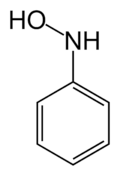Phenylhydroxylamine
| Phenylhydroxylamine | ||
|---|---|---|
 | ||
| IUPAC name N-phenylhydroxylamine | ||
| Other names beta-henylhydroxylamine; N-hydroxyaniline; phenylhydroxylamine; N-hydroxybenzeneamine; hydroxylaminobenzene | ||
| Identifiers | ||
| CAS number | 100-65-2 | |
| Jmol-3D images | Image 1 | |
| ||
| Properties | ||
| Molecular formula | C6H7NO | |
| Molar mass | 109.1274 g/mol | |
| Appearance | yellow needles | |
| Melting point | 80-81 °C | |
| Related compounds | ||
| Related compounds | hydroxylamine, nitrosobenzene | |
| Except where noted otherwise, data are given for materials in their standard state (at 25 °C (77 °F), 100 kPa) | ||
| Infobox references | ||
Phenylhydroxylamine is the organic compound with the formula C6H5NHOH. It is an intermediate in the redox-related pair C6H5NH2 and C6H5NO. Phenylhydroxylamine should not be confused with its isomer α-phenylhydroxylamine or O-phenylhydroxylamine, is C6H5ONH2.
Preparation and derivatives
This compound can be prepared by the reduction of C6H5NO2 with zinc in the presence of NH4Cl followed by crystallization as yellowish needles from salt-saturated water.[1][2] Alternatively, it can be prepared by transfer hydrogenation of C6H5NO2 using hydrazine as an H2 source over a rhodium catalyst.[3] The product can be purified from contaminating NaCl by extraction into benzene followed by precipitation with petroleum ether. C6H5NHOH is unstable to heating, and in the presence of strong acids easily rearranges to 4-aminophenol. Oxidation of phenylhydroxylamine with dichromate is a useful method of preparation of nitrosobenzene.
The compound condenses with benzaldehyde to form diphenylnitrone, a well-known 1,3-dipole:[4]
- C6H5NHOH + C6H5CHO → C6H5N(O)=CHC6H5 + H2O
References
- ↑ E. Bamberger “Ueber das Phenylhydroxylamin” Chemische Berichte, volume 27 1548-1557 (1894). E. Bamberger, "Ueber die Reduction der Nitroverbindungen" Chemische Berichte, volume 27 1347-1350 (1894) (first report).
- ↑ O. Kamm (1941), "Phenylhydroxylamine", Org. Synth.; Coll. Vol. 1: 445
- ↑ P. W. Oxley, B. M. Adger, M. J. Sasse, and M. A. Forth (1993), "N-Acetyl-N-Phenylhydroxylamine via Catalytic Transfer Hydrogenation of Nitrobenzene using Hydrazine and Rhodium on Carbon", Org. Synth.; Coll. Vol. 16: 16
- ↑ I. Brüning, R. Grashey, H. Hauck, R. Huisgen, H. Seidl (1973), "2,3,5-Triphenylisoxazolidine", Org. Synth.; Coll. Vol. 5: 1124